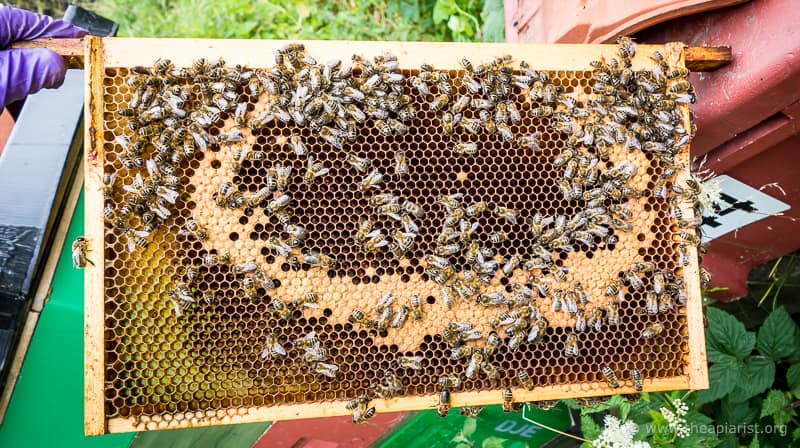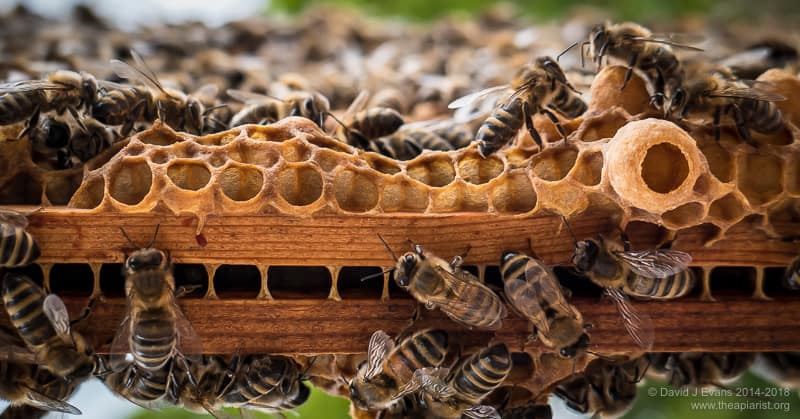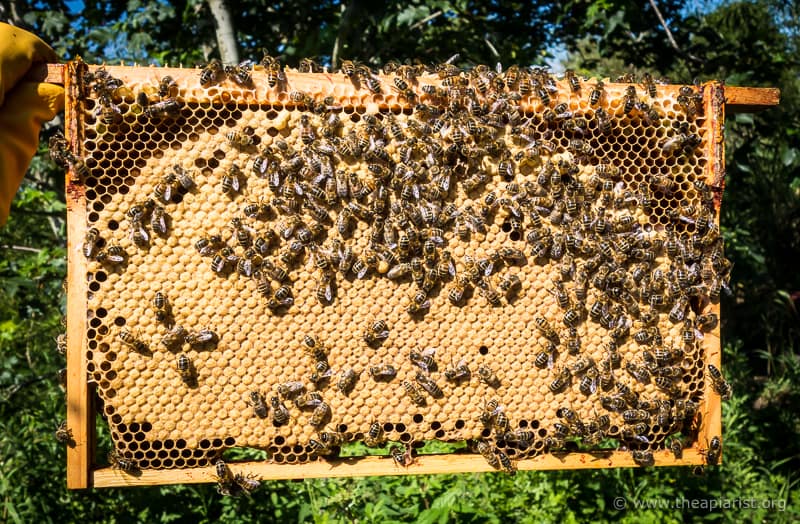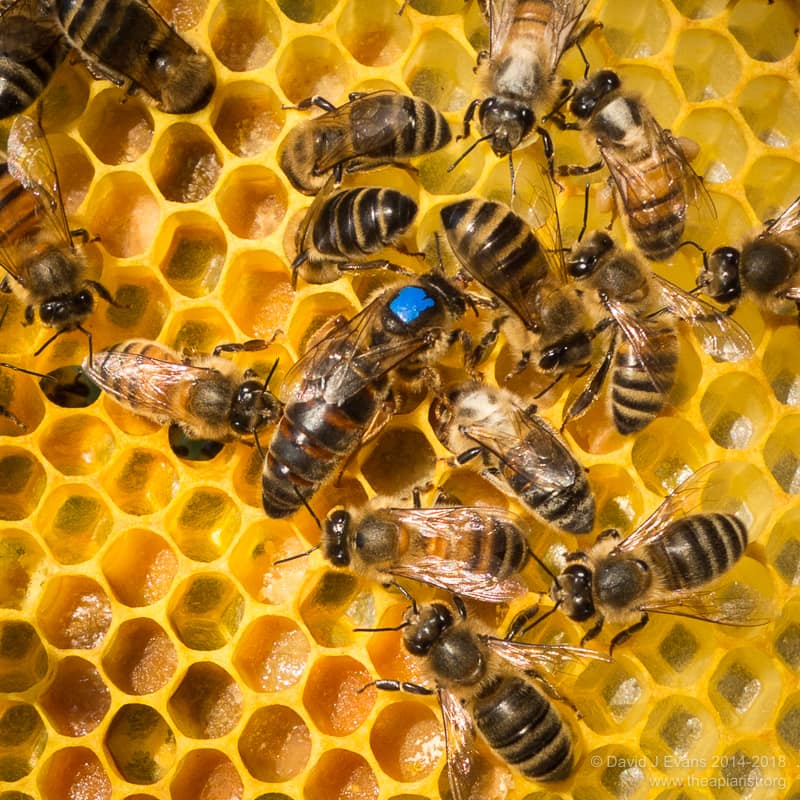Swarm prevention
Swarm prevention and control are distinct phases in the management of colonies during the next few weeks of the beekeeping season {{1}}.
Not all beekeepers practice them and not all colonies need them.
But most should and will … respectively 😉
Swarm prevention involves strategies to delay or stop the colony from initiating events that lead to swarming.
Swarm control strategies are more direct interventions that are used to prevent the loss of a swarm.
Why do colonies swarm?
Without swarming there would be no honey bees.
Swarming is honey bee colony reproduction. Without management (e.g. splitting colonies) colony numbers would remain static. And, since bees have only been managed for a few thousand years, they must have been successfully reproducing – by swarming – for millions of years before then.
So one of the major drivers of swarming is the innate need to reproduce.
Bees also swarm if their current environment is unable to accommodate further colony expansion. Therefore, another driver of swarming is overcrowding.
And, of course, there is some overlap in these two drivers of swarming.
You can therefore expect that strong, healthy, populous colonies will probably try to swarm on an annual basis.
The mechanics of swarming
When a colony swarms about 75% of the worker bees – of all age groups – leave with the queen. They set up a temporary bivouac near the original hive and subsequently relocate to a new nest site identified by the scout bees.
The original colony is left with all the brood (eggs, larvae and sealed brood), a significantly-depleted adult bee workforce and almost {{2}} all of the honey stores.
What they lack is a queen.
But what the swarm also leaves behind, amongst the brood, is one – or more often several – newly developing queens. These occupy specially enlarged cells that are located vertically on the edges or face of the comb.
Queen cells look distinctive and their initial appearance – before the swarm leaves – is a clear indication that the time for swarm prevention has gone and swarm control is now urgently needed {{3}}.
This is one of the reasons why regular colony inspections are essential, particularly during mid/late Spring and early summer which is the time of the season when swarming is most likely.
Colony fate and the risks of swarming
But back to the recently swarmed colony. In a few days the new queen(s) emerges. If there’s more than one they usually fight it out to leave just one. She goes on one or more mating flights and a few days later starts laying eggs.
This colony should survive and thrive. They have time to build up strength (and collect more stores) before the end of the season. Under natural conditions 87% of swarmed colonies overwinter successfully {{4}}.
Alternatively, the swarmed colony may swarm again (and again), each with a virgin queen and each further depleting the worker population. Colonies can swarm themselves to destruction like this.
Swarms headed by virgin queens are termed casts. I’m not sure what determines whether a swarmed colony also produces one or more casts. Colony strength is a determinant, but clearly not the only one as some casts contain little more than a cup full of bees.
Under natural conditions swarming is a very risky business. Swarm survival is less than 25% {{5}} – many will not collect sufficient stores to overwinter – and the survival of casts will be even lower because of their size and the risks associated with queen mating.
But ‘our’ bees don’t live under natural conditions
For beekeeping the ‘risks’ associated with swarming are somewhat different.
When a colony swarms you lose the majority of the workforce. Therefore honey production will be significantly reduced. You’re unlikely to get a surplus from the swarmed colony.
Of course, honey might not interest you but propolis and wax production are also reduced, as is the strength of the colony to provide efficient ecosystem services (pollination).
Secondly, despite swarms being one of the most captivating sights in beekeeping, not everyone appreciates them. Non-beekeepers may be scared and – extraordinary as it may seem – resent the swarm establishing a new nest in the eaves of their house.
Incoming! from The Apiarist on Vimeo.
Inevitably some beekeepers will claim they’ve never met anyone scared of bees, or swarms are always welcomed in the gardens that abut their apiary.
Unfortunately, that does not alter the reality that – to many – swarms are a nuisance, a potential threat and (to a small number of people {{6}} ) a very real danger.
Therefore, as beekeepers, we have a responsibility to practice both swarm prevention and control. This prevents our hobby/obsession irritating other people and means we have more bees to make delicious honey for family, friends and customers.
Overcrowding
I’ve already defined the event that separates swarm prevention from swarm control. It is the appearance of queen cells during the weekly colony inspection.
Swarm prevention involves managing the colony to delay the appearance of queen cells. Once queen cells are produced, swarm control is required {{7}}
I’ve also defined the two major drivers of swarming – overcrowding and the need to reproduce {{8}}.
How does a colony determine that it is overcrowded? As beekeepers, how can we monitor and prevent overcrowding?
As a colony expands during the spring the queen lays concentric rings of eggs from the centre of the brood nest. Imagine this initially as a kiwi fruit-sized ball, then an orange, then a grapefruit, until it is the size of a large football.
Perhaps a slightly squashed football, but you get the general idea.
Running out of storage space
It takes bees to make bees. The initial brood reared helps feed subsequent larvae and keeps the maturing brood warm.
As the season develops more sources of nectar and pollen become available. These are collected in increasing amounts by the expanding numbers of foragers.
This all needs to be stored somewhere.
One possibility is that the stores are loaded into the cells recently vacated by emerging workers within the brood nest. This is often termed “backfilling”. Sometimes you find a frame in which the central concentric rings of brood have emerged and, before the queen has had a chance to re-lay the frame with new eggs, workers have backfilled the cells with nectar (or, less frequently, pollen).
But, at the same time as the space available for the queen to lay is reducing, the colony population is increasing. Very fast. There are larger numbers of unemployed young bees. Unemployed because there are reduced amounts of brood to rear because the queen is running out of space.
Pheromones
And the increased number of workers means that the pheromones produced by the queen, in particular the queen mandibular pheromone, are effectively diluted. Studies by Mark Winston and colleagues {{9}} investigated the relationship between queen mandibular pheromone (an inhibitor of queen cell production) and colony congestion. In it he concluded that overcrowding inhibits the transmission of this pheromone, so favouring queen cell production.
The distribution of other pheromones is also reduced in overcrowded colonies. Lensky and Slabezki {{10}} showed that the queen rarely visited the bottom edges of comb in overcrowded colonies. Consequently, the levels of queen footprint pheromone was reduced. This pheromone is an inhibitor of queen cup production, the very earliest stages of queen cell development.
So, overcrowded colonies start to prepare queen cells … and swarm control is needed.
Make space
If the colony is overcrowded then you have to provide more space for colony expansion.
Just piling supers on top may not be sufficient, though it may temporarily ease congestion and partially help. Leaving a colony with no supers during a strong nectar flow is a surefire way to fill the brood box with nectar and trigger swarm preparation.
If the colony is backfilling the brood nest with nectar then the addition of supers is likely to encourage them to move the stores up, providing more space for the queen.
It will additionally have the beneficial effect of moving some bees ‘up’, to store and process the nectar, again reducing congestion in the brood nest.
However, you probably also need to encourage the bees to expand the brood nest by providing frames for them to draw out as comb. Essentially you’re spreading the brood nest by inserting one or two empty frames within it.
Expanding or spreading the brood nest
I routinely do this by removing the outer frames, which often contain stores, and adding new foundationless frames on one or both sides of the centre of the brood nest. Usually I would place these about three to four frames apart {{11}}.
Effectively I’m providing the bees with the space to draw more comb and, in due course, for the queen to lay more eggs.
And all this keeps the workers gainfully employed and so helps alleviate overcrowding.
But what do you do if the box is full of full brood frames?
You provide another brood box.
Don’t just dump another brood box on top and expect the bees to immediately move up. It’s a big empty space. Ideally provide some drawn comb and move a frame or two up with emerging bees and the queen. She will rapidly start to lay up the vacated cells and the adjacent frames. Push the original frames together and add new empty frames to fill the box.
You are expanding the brood nest … vertically.
My colonies rarely need this as they are the less prolific, darker bees which tend to perform better overall in Scotland. However, some strains of bees readily fill two stacked brood boxes every season.
It’s worth emphasising again that these swarm prevention interventions are of little or no use for swarm control. If there are queen cells already present adding a frame or two of foundation will have no effect at all.
Young queens
Young queens produce more pheromones than ageing queens. Therefore, all other things being equal, the inhibitory effects of queen mandibular and footprint pheromones will be stronger in a colony headed by a young queen.
This is why colonies are less likely to swarm in their first full season {{12}}.
You can routinely replace queens by purchasing new ones, by rearing your own, or through colony manipulation during swarm control e.g. by reuniting a vertical split.
Of these, I’d strongly recommend one of the last two approaches. It’s more interesting, it’s a whole lot more satisfying and it is a lot easier than many beekeepers realise.
You have the additional advantage that the queens produced in your own apiary will – by definition – be local and there is good evidence that local queens are better adapted to local conditions.
Robbing brood and making nucs
There are at least two additional, and related, ways of increasing the space available so helping swarm prevention in a rapidly expanding colony.
The first is stealing a frame of brood {{13}} and using it to boost a weaker colony.
Take care when doing this.
If the recipient colony is weak due to disease or a failing queen then you’re just wasting the donated brood. However, if the colony is healthy but small it can be a good investment of resources and may help delay swarming in the donor colony as well.
More drastically, it may be possible to remove a frame (or perhaps even two) of brood and adhering bees to make up a nucleus colony. In my experience, a strong donor colony can almost always be used to produce a nuc without compromising honey production, and with the added benefit of delaying swarm preparations.
I’m going to write about nuc production in more detail in a few weeks as it deserves a full post of its own. It’s worth noting here that the nuc should also be provided with sufficient bees and stores to survive and you will need a queen for it (or at least a queen cell).
Do not just dump a couple of brood frames and bees into a box and expect them to rear a half-decent queen on their own.
However, if you have a queen (or mature queen cell) then splitting a nuc off a strong colony is usually a win-win solution for swarm prevention.
{{1}}: Of course, should you be reading this in September be aware that it was written in mid April (in Scotland) and so may only be immediately relevant if you live in the southern hemisphere.
{{2}}: A swarm gorges on honey before it leaves the hive, hence ‘almost’.
{{3}}: Once a colony has started queen cells it’s probably too late for swarm prevention measures … you might be able to delay things, but swarm control must be the priority. They rarely change their minds!
{{4}}: Seeley, TD. (2017) Life-history traits of wild honey bee colonies living in forests around Ithaca, NY, USA. Apidologie 48, 743–754.
{{5}}: Ibid.
{{6}}: Those with serious allergies who may go into anaphylactic shock if stung.
{{7}}: Swarm control has been covered several times previously (and will be again) but for starters you could read about vertical splits, Pagdens’ artificial swarm, Demareeing or the nucleus method of swarm control.
{{8}}: As with teenagers, the drive to reproduce (!) is innate and more-or-less unstoppable … so I’ll focus on overcrowding.
{{9}}: Winston et al., (1991) The role of queen mandibular pheromone and colony congestion in honey bee (Apis mellifera L.) reproductive swarming. J. Insect. Behav. 4, 649–660.
{{10}}: Lensky & Slabezki (1981) The inhibiting effect of the queen bee (Apis mellifera L.) foot-print pheromone on the construction of swarming queen cups. J. Insect Physiol. 27: 313-323.
{{11}}: So, if the box started with stores (S) and brood (B) distributed SSBBBBBBBBS with B indicating the approximate centre of the brood nest I might add the new (N) frames to leave SBBNBBBBNBB.
{{12}}: A queen reared in 2019 is entering her first full season this year, 2020.
{{13}}: Brood alone, no adhering bees.





Join the discussion ...